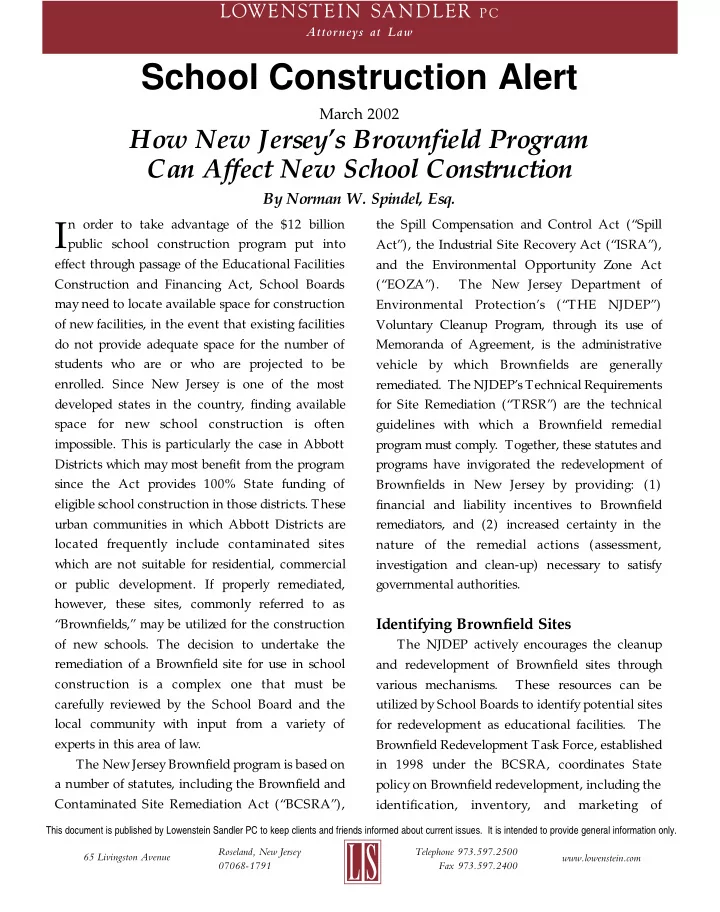

G School Construction Alert March 2002 How New Jersey’s Brownfield Program Can Affect New School Construction By Norman W. Spindel, Esq. n order to take advantage of the $12 billion the Spill Compensation and Control Act (“Spill I public school construction program put into Act”), the Industrial Site Recovery Act (“ISRA”), effect through passage of the Educational Facilities and the Environmental Opportunity Zone Act Construction and Financing Act, School Boards (“EOZA”). The New Jersey Department of may need to locate available space for construction Environmental Protection’s (“THE NJDEP”) of new facilities, in the event that existing facilities Voluntary Cleanup Program, through its use of do not provide adequate space for the number of Memoranda of Agreement, is the administrative students who are or who are projected to be vehicle by which Brownfields are generally enrolled. Since New Jersey is one of the most remediated. The NJDEP’s Technical Requirements developed states in the country, finding available for Site Remediation (“TRSR”) are the technical space for new school construction is often guidelines with which a Brownfield remedial impossible. This is particularly the case in Abbott program must comply. Together, these statutes and Districts which may most benefit from the program programs have invigorated the redevelopment of since the Act provides 100% State funding of Brownfields in New Jersey by providing: (1) eligible school construction in those districts. These financial and liability incentives to Brownfield urban communities in which Abbott Districts are remediators, and (2) increased certainty in the located frequently include contaminated sites nature of the remedial actions (assessment, which are not suitable for residential, commercial investigation and clean-up) necessary to satisfy or public development. If properly remediated, governmental authorities. however, these sites, commonly referred to as “Brownfields,” may be utilized for the construction Identifying Brownfield Sites of new schools. The decision to undertake the The NJDEP actively encourages the cleanup remediation of a Brownfield site for use in school and redevelopment of Brownfield sites through construction is a complex one that must be various mechanisms. These resources can be carefully reviewed by the School Board and the utilized by School Boards to identify potential sites local community with input from a variety of for redevelopment as educational facilities. The experts in this area of law. Brownfield Redevelopment Task Force, established The New Jersey Brownfield program is based on in 1998 under the BCSRA, coordinates State a number of statutes, including the Brownfield and policy on Brownfield redevelopment, including the Contaminated Site Remediation Act (“BCSRA”), identification, inventory, and marketing of This document is published by Lowenstein Sandler PC to keep clients and friends informed about current issues. It is intended to provide general information only. L Roseland, New Jersey Telephone 973.597.2500 65 Livingston Avenue www.lowenstein.com 07068-1791 Fax 973.597.2400
G protection does not come without cost. Simply Brownfield sites in New Jersey. Site information is made publicly-available on the NJDEP’s stated, a person is protected from future liability only for those conditions that are investigated and Geographic Information System (“GIS”). remediated, as appropriate, to the satisfaction of Additionally, the Task Force provides planning the NJDEP. Such investigation and remediation Perhaps the most significant incentive to must occur in accord with the NJDEP’s Brownfield redevelopment in New Jersey comprehensive technical regulations for site investigation and remediation. These regulations is the limitation on liability that the State specify how a person is to investigate groundwater, offers to those who remediate sites. surface water, soil and other environmental assistance to local governments in their own contamination, and the process to be utilized in evaluating and ultimately choosing the remedy for efforts at Brownfield redevelopment. such contamination. The NJDEP’s technical In addition, the NJDEP’s Site Remediation Program periodically publishes its Known program also requires the evaluation of ecological damage. The NJDEP’s current policy is not to Contaminated Sites in New Jersey, a publicly- insist upon the active remediation of available inventory of contaminated sites in New Jersey. This list is only part of the more extensive environmental contamination in all instances, although there will be a bias towards active Comprehensive Site List, which also includes No remediation in areas occupied by school children. Further Action sites (a listing of sites which presently require no further remediation) and In instances where it can be demonstrated to the NJDEP that leaving residual contamination above Sites Under Review (a listing of sites which the most restrictive numerical cleanup criterion for require further investigation to determine if they are contaminated). a particular contaminant will not pose a threat to the school population, the NJDEP may not insist Recently, the NJDEP launched “I-Map NJ on active remediation. Brownfields,” its free on-line mapping application which allows users to access information about However, it is likely that engineering and/ or institutional controls will be required by the known Brownfield sites in New Jersey. The easily NJDEP. Engineering controls limit the potential accessible database uses interactive maps which allow school officials and other stakeholders for human contact with contaminated soils. The most common example of engineering controls are interested in redeveloping Brownfields to quickly fencing and capping of contaminated areas. The obtain information about site locations and their characteristics. most common institutional controls are well restriction areas that preclude the installation or Limitation on Liability use of groundwater wells located in contaminated Perhaps the most significant incentive to areas, and deed notices that put the public on notice of the existence of elevated levels of Brownfield redevelopment in New Jersey is the contamination at a property. Deed notices are limitation on liability that the State offers to those who remediate sites. But this liability recorded in county registries along with property
Recommend
More recommend